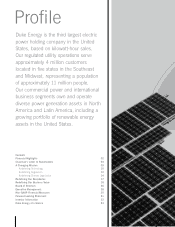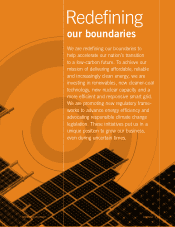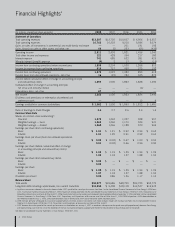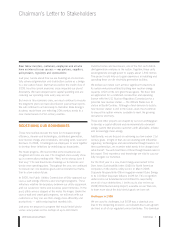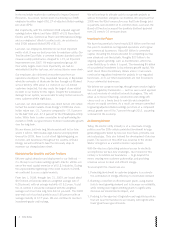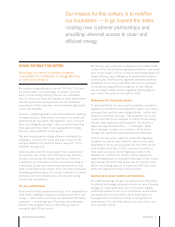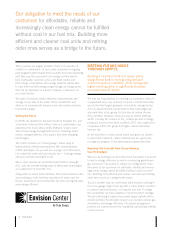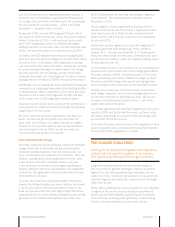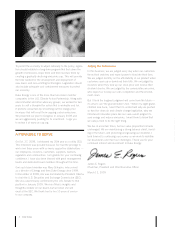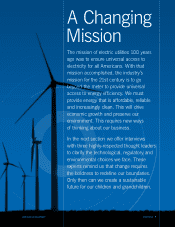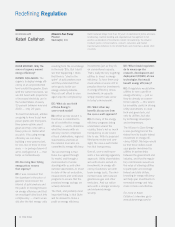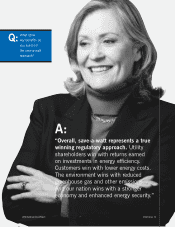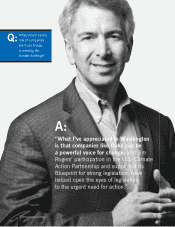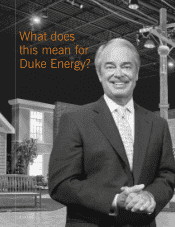Duke Energy 2008 Annual Report Download - page 12
Download and view the complete annual report
Please find page 12 of the 2008 Duke Energy annual report below. You can navigate through the pages in the report by either clicking on the pages listed below, or by using the keyword search tool below to find specific information within the annual report.
10 Duke Energy 10 Duke Energy
DUKE ENERGY: What new
technologies do you see
coming into the energy space
in the next five years, and
what impact will they have?
LARRY MAKOVICH: Clearly
the technology that every-
body’s excited about is the
smart grid. Duke Energy is
among a number of power
companies at the leading
edge of this innovation.
The smart grid will reshape
power demand, deliver greater
efficiency and provide things
like better security for homes
and businesses. It will enable
better predictive maintenance
capabilities and improved
environmental accountability.
The smart grid is a near-term
technology that’s very prom-
ising, and it will be exciting
to track it over the next five
years and beyond.
DE: How does the smart
grid work?
LM: A lot of people think the
smart grid is just the applica-
tion of advanced meters. It’s
a lot more than that, and
the biggest impact of this
innovation isn’t going to come
from just a single metering
or measurement technology.
It’s going to be a combination
of measurement devices,
sensing technologies, infor-
mation technology, communi-
cation technology and even
things like nanotechnology
and optimization software.
I think that within five years
a smarter grid will fundamen-
tally change the way electric
customers interact with
their suppliers.
DE: How can the traditional
cost-of-service regulatory
utility model survive? How
can it be moved into the
21st century to promote
the benefits of new
technologies?
LM: Regulations have always
focused on traditional electric
service, which is often just
measured in kilowatt-hours
of energy consumed or mega-
watts of peak demand. When
you think about the future
and these expanding bound-
aries, regulators will have to
think about regulatory struc-
tures that support efficiency
gains. Importantly, regulations
ought to evolve to provide the
same kind of positive incen-
tive to reduce power demand
as they currently do to
increase power supply.
For instance, regulators will
have to come up with ways
to deal with the economics of
solar panels and other forms
of distributed generation.
This revolution will allow
customers and the utility to
rely on the grid as a virtual
battery that they can put
surplus power into when
they’ve got it, and take
energy out of when they need
it. There are going to be new
functions and new capabilities
beyond the traditional prod-
ucts. Regulators will have
to define and allow for cost
recovery of these products
and programs. This will
ensure that power suppliers
evolve and grow at the same
pace as new technology
development.
DE: We’re in a period of
rising energy prices. We’re
in a recession and Congress
may pass climate legislation
in 2009 or 2010, which will
further impact energy prices.
As an industry, how do we
leverage technology while
keeping prices affordable?
LM: It is a challenging envi-
ronment. The real price of
electricity has been increasing
in this country for several
years. There’s no one thing —
whether it’s a push for more
renewables, a push for more
efficiency or a push to put a
price on carbon — that’s going
to be the straw that breaks
the camel’s back. All of
them are creating upward
momentum for power prices.
That puts a premium on the
need for very intelligent
federal and state rules and
regulations to accomplish
these goals efficiently and
cost-effectively.
Left uncoordinated, accumu-
lated costs will drive up
energy prices to levels that
are politically intolerable.
DE: In your view, is scale
important to promote
new technologies?
LM: Companies need the
critical mass to sustain the
experimentation and deploy-
ment of new technologies.
They have to be big enough
to partner with universities
and labs to work together to
do basic research and extend
innovations into power appli-
cations. They need to team
up with regulators to imple-
ment pilot programs to gain
the experience and knowledge
needed to roll out new
technologies for all of
their customers.
Companies that can help
create clusters of basic
research and development,
engineering applications and
regulatory support, and inte-
grate them into their existing
business, will be the ones
that sustain themselves in
the future. Research Triangle
Park in North Carolina
is a good example of one of
these clusters.
For more of Larry
Makovich’s interview, go to
www.duke-energy.com/ar.
Redefining Technology
An interview with
Larry Makovich
Cambridge Energy Research
Associates
Vice President and Senior Advisor
Cambridge, Mass.
Larry Makovich is a highly respected expert on electric power market
structures, demand and supply fundamentals, wholesale and retail power
markets, emerging technologies, asset valuations and strategies. He directs
CERA’s research efforts in the Global Power Group and is an authority on
electricity markets, regulation, economics and strategy.


